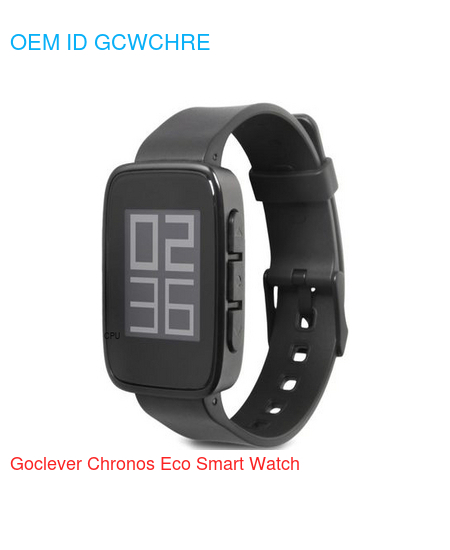| Brand | Goclever |
| Model | Chronos Eco Smart Watch |
| Released | 2015 Aug |
| OEM ID | GCWCHRE |
| Device Category | Smartwatch |
| Width | 35 mm |
| Height | 44 mm |
| Depth | 11 mm |
| Dimensions | 1.38×1.73×0.43 inches |
| Mass | 36 g |
| Platform | Android |
| Operating System | Google Android 4.4 (KitKat) |
| CPU | ARM Cortex-M0, 2009, 32 bit, single-core |
| RAM Type | SRAM |
| RAM Capacity (converted) | N/A |
| Non-volatile Memory Interface | Yes |
| Display Diagonal | 32 mm |
| Resolution | 144×168 |
| Horizontal Full Bezel Width | 14.17 mm |
| Display Area Utilization | 32.9% |
| Pixel Density | 176 PPI |
| Display Type | Mono TFT LCD display |
| Scratch Resistant Screen | No |
| Graphical Controller | N/A |
| A/V Out | No |
| Microphone(s) | No |
| Loudspeaker(s): | No |
| Audio Output: | No |
| Supported Cellular Bands | No |
| Complementary Phone Services | Vibrate |
| Sec. Supported Cellular Networks: | No |
| Touchscreen Type | Capacitive multi-touch screen |
| Expansion Interfaces | No |
| USB | USB 2.0 |
| USB Services | USB charging |
| USB Connector | USB Micro-B (Micro-USB) |
| Bluetooth | Bluetooth 4.0 |
| Wireless LAN | No |
| FM Radio Receiver | No |
| Camera Image Sensor | No |
| Focus | No |
| Flash | No |
| Aux. Camera Image Sensor | No |
| Aux. 2 Camera Image Sensor | No |
| Aux. 3 Camera Image Sensor | No |
| Aux. 4 Camera Image Sensor | No |
| Secondary Camera Sensor | No |
| Sec. Aux. Cam. Image Sensor | No |
| Built-in accelerometer | Yes |
| Built-in gyroscope | 3D gyro |
| Additional sensors | Step counter |
| Protection from solid materials | Yes |
| Protection from liquids | Yes |
| Battery | Li-ion |
| Nominal Battery Capacity | 110 mAh battery |
| Added | 2024-06-24 |
Specifications data description of this 📱Goclever Chronos Eco Smart Watch📱
Title: Specification of the Device: A Comprehensive Look
Introduction
————
In today’s fast-paced world, technology has become an essential part of our lives. With a multitude of devices available in the market, it becomes crucial to understand the specifications of the device before making a purchase. In this blog post, we will take an in-depth look at the specifications of a device and what each specification means. So, let’s get started!
Lineup
——
The lineup of the device refers to its placement in the market. It could be an entry-level, mid-range, or high-end device. The lineup determines the features and specifications of the device.
Design
——
The design of the device is an essential factor in its appeal to the users. A sleek, ergonomic design not only enhances the user experience but also adds to the aesthetic value of the device.
Specifications
————–
Now, let’s dive into the nitty-gritty of the device’s specifications.
🌐 Network: The network specification indicates the connectivity options available on the device. It includes 2G, 3G, 4G, and 5G networks, Wi-Fi, Bluetooth, and GPS.
LAUNCH📅: The launch date of the device gives an idea of its market availability.
🏋️ Body: The body specification includes the dimensions, weight, and build material of the device.
🌈 Display: The display specification includes the screen size, resolution, aspect ratio, and technology used in the display.
🤖 OS 🛠️: The operating system and the version of the device determine the compatibility of the device with various applications and software.
🚀 Chipset 🔧: The chipset specification includes the make and model of the chipset used in the device. It determines the processing power of the device.
💪 CPU 🖥️: The CPU specification includes the number of cores, clock speed, and architecture of the CPU.
🎮 GPU 💻: The GPU specification includes the make and model of the GPU used in the device. It determines the graphics processing capabilities of the device.
🧠 MEMORY 🗂️: The memory specification includes the RAM and ROM of the device. It determines the multitasking capabilities and storage capacity of the device.
📷 CAMERA 🎥: The camera specification includes the megapixel count, aperture, and features of the rear and front cameras.
🔈 SOUND 🎵: The sound specification includes the make and model of the audio chip, speaker configuration, and audio enhancement features.
📡 COMMS 📶: The communication specification includes the connectivity options available on the device.
💡 FEATURES 🎁: The features specification includes any unique or additional features available on the device, such as a fingerprint scanner, face unlock, or water resistance.
🔋 BATTERY🔌: The battery specification includes the battery capacity and type, fast charging capabilities, and standby time.
Conclusion
———-
In conclusion, understanding the specifications of a device is crucial in making an informed decision while purchasing. It helps in determining whether the device meets the user’s requirements and budget. We hope this comprehensive look at the specifications of the device has been informative and helpful. We invite our readers to leave a comment and share their thoughts on the post.














